Abstract
An investigation was made into the effect of Corynebacterium parvum therapy on cerebral tumours in mice. I.v. C. parvum caused a slight but significant increase in the survival of BALB/c mice injected intracerebrally (i.c.) with not more than 50 Meth A cells. C. parvum was most effective if given on the same day or 5 days after tumour. If this interval was increased there was no effect. Multiple i.v. injections were no more effective than a single dose. I.v. C. parvum had no influence on the survival of C57BL mice injected i.c. with Lewis tumour cells, and had little effect on the induction of i.c. or s.c. tumours by methylcholanthrene. It was concluded that C. parvum therapy was of little use in the treatment of cerebral tumour in mice. The clinical implications of these findings are discussed.
Full text
PDF
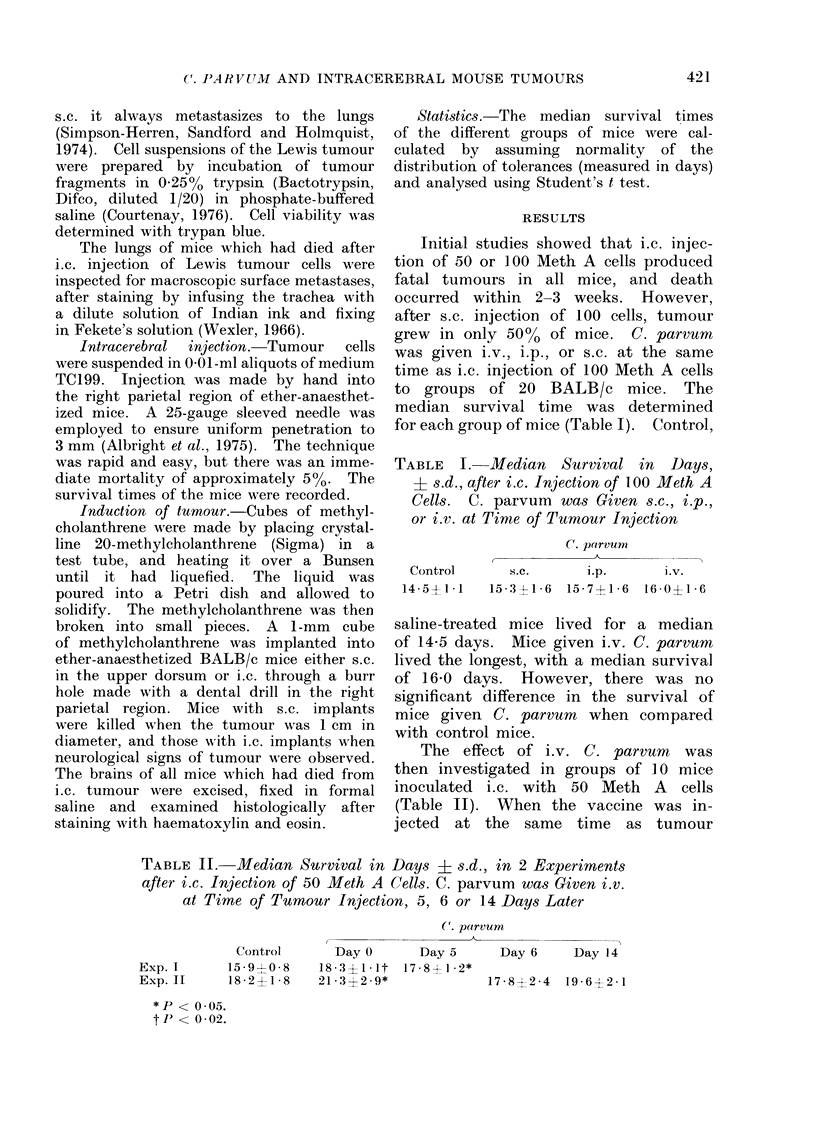
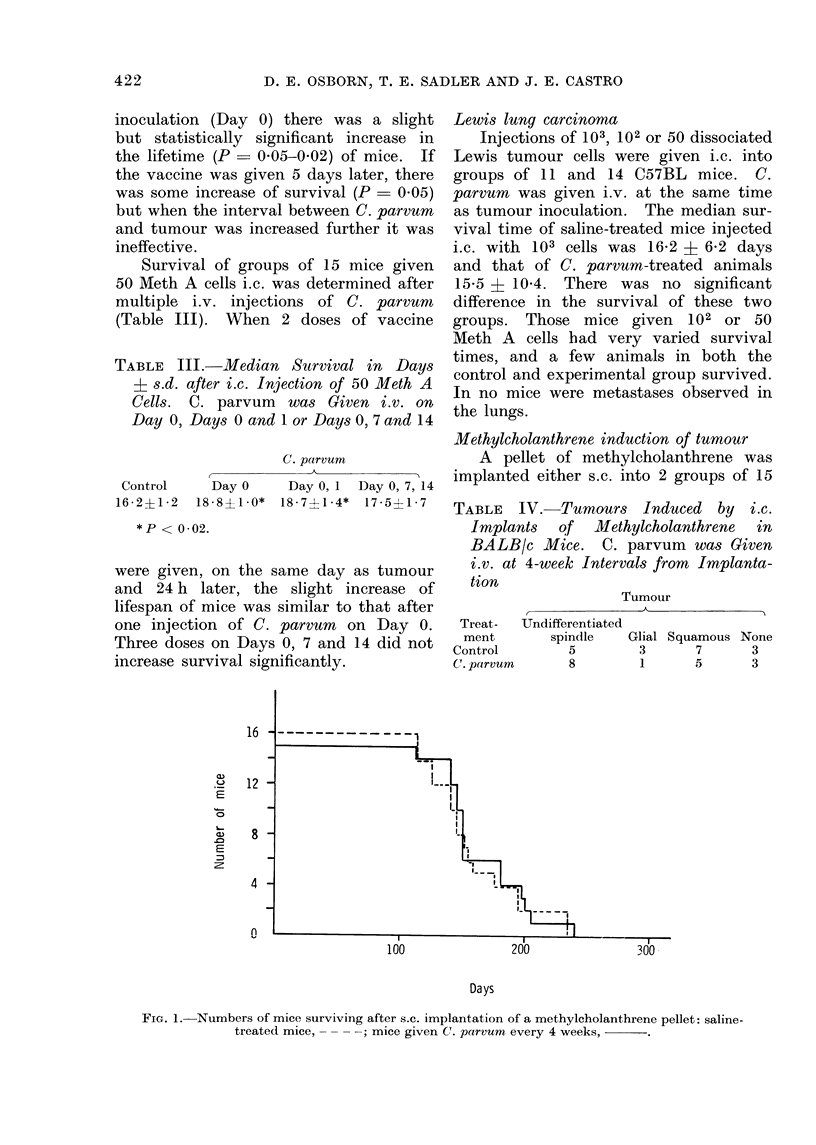
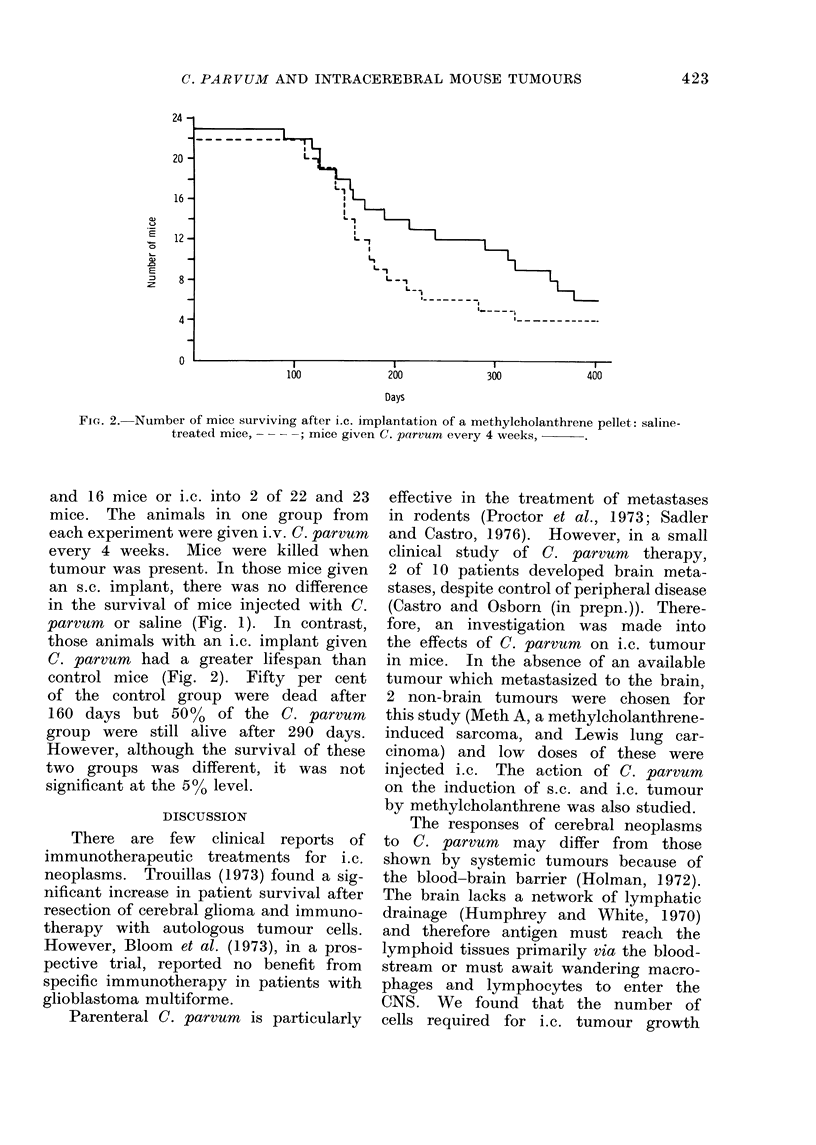
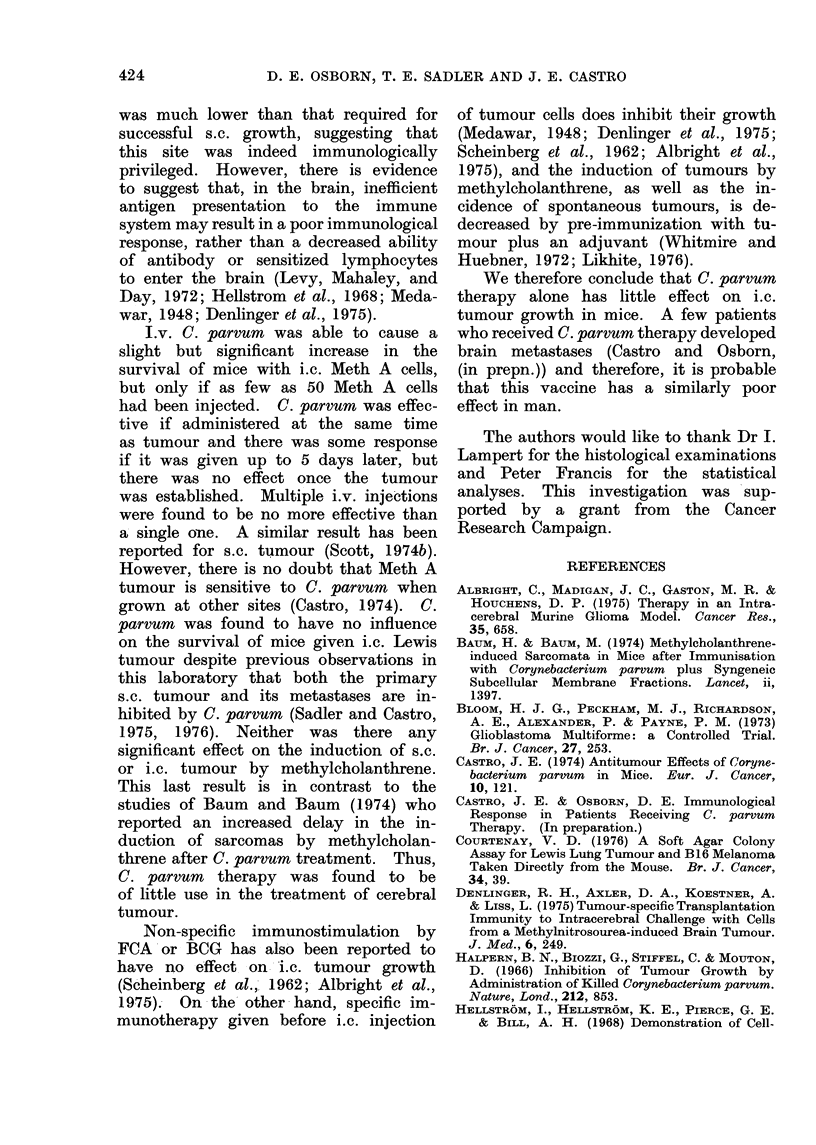
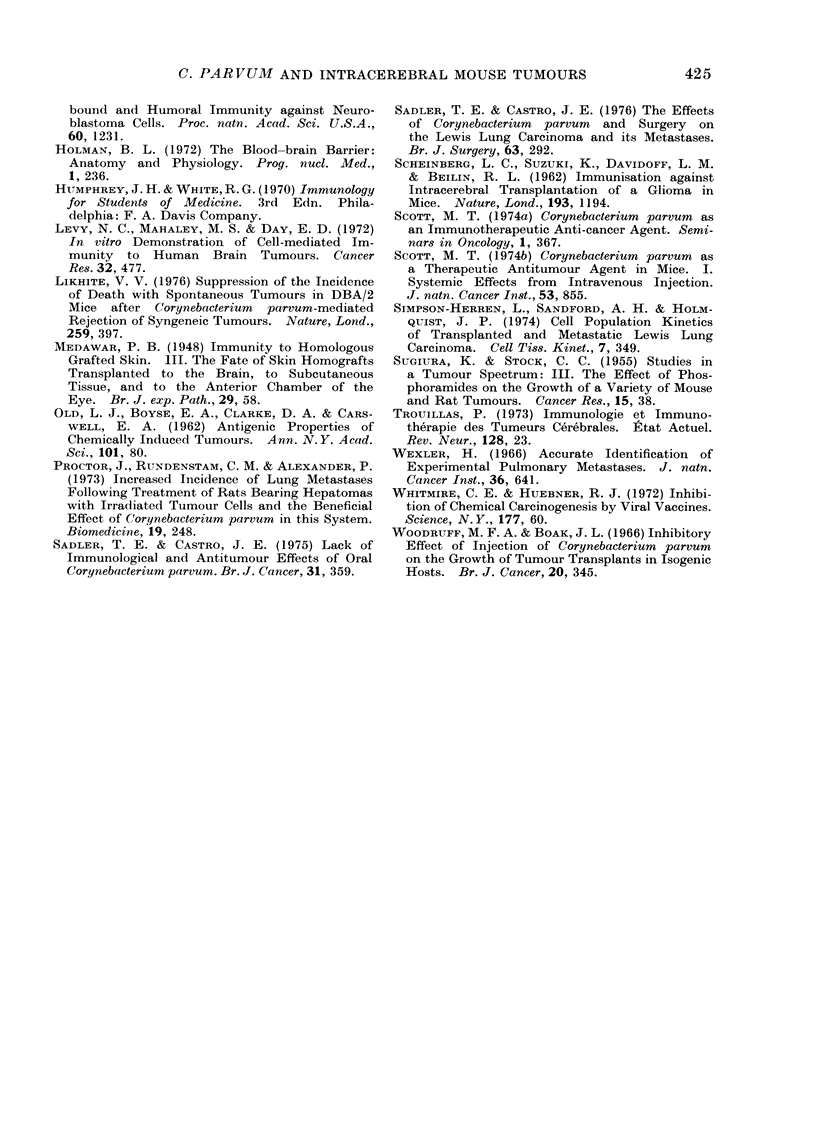
Selected References
These references are in PubMed. This may not be the complete list of references from this article.
- Albright L., Madigan J. C., Gaston M. R., Houchens D. P. Therapy in an intracerebral murine glioma model, using Bacillus Calmette-Guérin, neuraminidase-treated tumor cells, and 1-(2-chloroethyl)-3-cyclohexyl-1-nitrosourea. Cancer Res. 1975 Mar;35(3):658–665. [PubMed] [Google Scholar]
- Baum H., Baum M. Letter: Methyl-cholanthrene-induced sarcomata in mice after immunisation with Corynebacterium parvum plus syngeneic subcellular membrane fractions. Lancet. 1974 Dec 7;2(7893):1397–1398. doi: 10.1016/s0140-6736(74)92279-x. [DOI] [PubMed] [Google Scholar]
- Bloom H. J., Peckham M. J., Richardson A. E., Alexander P. A., Payne P. M. Glioblastoma multiforme: a controlled trial to assess the value of specific active immunotherapy in patients treated by radical surgery and radiotherapy. Br J Cancer. 1973 Mar;27(3):253–267. doi: 10.1038/bjc.1973.30. [DOI] [PMC free article] [PubMed] [Google Scholar]
- Castro J. E. Antitumour effects of Corynebacterium parvum in mice. Eur J Cancer. 1974 Feb;10(2):121–127. doi: 10.1016/0014-2964(74)90063-2. [DOI] [PubMed] [Google Scholar]
- Courtenay V. D. A soft agar colony assay for Lewis lung tumour and B16 melanoma taken directly from the mouse. Br J Cancer. 1976 Jul;34(1):39–45. doi: 10.1038/bjc.1976.119. [DOI] [PMC free article] [PubMed] [Google Scholar]
- Denlinger R. H., Axler D. A., Koestner A., Liss L. Tumor-specific transplantation immunity to intracerebral challenge with cells from a methylnitrosourea- induced brain tumor. J Med. 1975;6(3-4):249–259. [PubMed] [Google Scholar]
- Halpern B. N., Biozzi G., Stiffel C., Mouton D. Inhibition of tumour growth by administration of killed corynebacterium parvum. Nature. 1966 Nov 19;212(5064):853–854. doi: 10.1038/212853a0. [DOI] [PubMed] [Google Scholar]
- Holman B. L. The blood brain barrier: anatomy and physiology. Prog Nucl Med. 1972;1:236–248. [PubMed] [Google Scholar]
- Levy N. L., Mahaley M. S., Jr, Day E. D. In vitro demonstration of cell-mediated immunity to human brain tumors. Cancer Res. 1972 Mar;32(3):477–482. [PubMed] [Google Scholar]
- Likhite V. V. Suppression of the incidence of death with spontaneous tumours in DBA/2 mice after Corynebacterium parvum-mediated rejection of syngeneic tumours. Nature. 1976 Feb 5;259(5542):397–399. doi: 10.1038/259397a0. [DOI] [PubMed] [Google Scholar]
- Proctor J., Rudenstam C. M., Alexander P. Increased incidence of lung metastases following treatment of rats bearing hepatomas with irradiated tumour cells and the benefical effect of Corynebacterium parvum in this system. Biomedicine. 1973 Jun 20;19(6):248–252. [PubMed] [Google Scholar]
- SCHEINBERG L. C., SUZUKI K., DAVIDOFF L. M., BEILIN R. L. Immunization against intracerebral transplantation of a glioma in mice. Nature. 1962 Mar 24;193:1194–1195. doi: 10.1038/1931194a0. [DOI] [PubMed] [Google Scholar]
- SUGIURA K., STOCK C. C. Studies in a tumor spectrum. III. The effect of phosphoramides on the growth of a variety of mouse and rat tumors. Cancer Res. 1955 Jan;15(1):38–51. [PubMed] [Google Scholar]
- Sadler T. E., Castro J. E. Lack of immunological and anti-tumour effects of orally administered Corynebacterium papvum in mice. Br J Cancer. 1975 Mar;31(3):359–363. doi: 10.1038/bjc.1975.71. [DOI] [PMC free article] [PubMed] [Google Scholar]
- Sadler T. E., Castro J. E. The effects of Corynebacterium parvum and surgery on the Lewis lung carcinoma and its metastases. Br J Surg. 1976 Apr;63(4):292–296. doi: 10.1002/bjs.1800630410. [DOI] [PubMed] [Google Scholar]
- Scott M. T. Corynebacterium parvum as an immunotherapeutic anticancer agent. Semin Oncol. 1974 Dec;1(4):367–378. [PubMed] [Google Scholar]
- Trouillas P. Immunologie et immunothérapie des tumeurs cérébrales. Etat actuel. Rev Neurol (Paris) 1973 Jan;128(1):23–38. [PubMed] [Google Scholar]
- Wexler H. Accurate identification of experimental pulmonary metastases. J Natl Cancer Inst. 1966 Apr;36(4):641–645. doi: 10.1093/jnci/36.4.641. [DOI] [PubMed] [Google Scholar]
- Whitmire C. E., Huebner R. J. Inhibition of chemical carcinogenesis by viral vaccines. Science. 1972 Jul 7;177(4043):60–61. doi: 10.1126/science.177.4043.60. [DOI] [PubMed] [Google Scholar]
- Woodruff M. F., Boak J. L. Inhibitory effect of injection of Corynebacterium parvum on the growth of tumour transplants in isogenic hosts. Br J Cancer. 1966 Jun;20(2):345–355. doi: 10.1038/bjc.1966.42. [DOI] [PMC free article] [PubMed] [Google Scholar]


